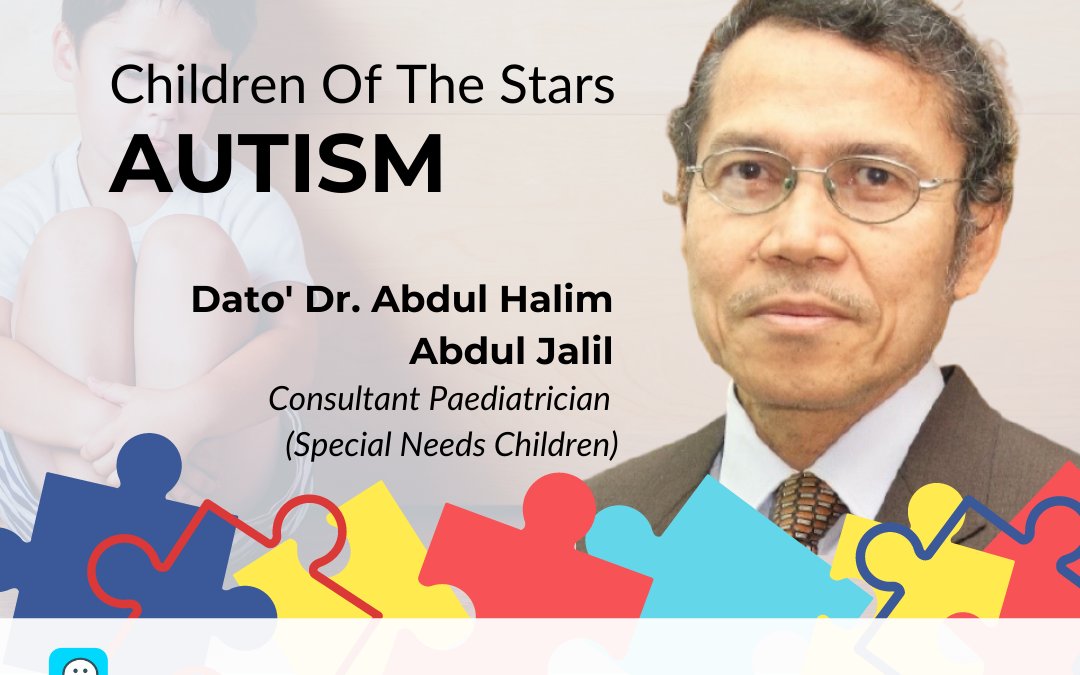[TDMC] Children Of The Stars-AUTISM

[TDMC] CANCER OF THE CERVIX-Can It Be Prevented?
5 January 2022
[TDMC]: Physiotherapy @ KMI-Taman Desa Medical Centre
26 January 2022There are hundreds of thousands of families in Malaysia who are affected by autism. Children with autism face challenges with their social behaviour and communication skills. While there is no single apparent cause of autism in children, early diagnosis can help you provide the support your child needs in order to ensure a better quality of life.
What Is Autism?
Autism, also termed autism spectrum disorder (ASD), is a broad term for developmental and neurological disorders that affect how a person perceives, communicates, and interacts with others. The Diagnostic and Statistical Manual of Mental Disorders (DSM-5) describes autism as:
- Repetitive patterns of behaviours and restricted interests
- Continuous challenges of social communication and interaction.
- The inability of a child to function properly in school and other areas of life.
The symptoms of autism become clearly noticeable in early childhood, particularly in the first two years of life and last throughout an individual’s life. Autism affects children of all economic, racial, and ethnic groups [1].
The symptoms of autism and the ability of a child to function can be improved with treatment and evaluation. All children should be screened for autism, says the American Academy of Pediatrics (AAP).
Prevalence Of Autism
According to Centre for Disease Control (CDC) in United States, the incidence of autism are at 1 in 68 children. That would mean that approximate 9,000 children in Malaysia are born with autism every year [9].
In the United Kingdom, the prevalence rates of autism have shown a sharp increase from 2010 to 2019 in UK schools [2].Studies have reported that 1 per 100 children in the United Kingdom is currently affected by autism [3].
CDC have also reported that boys are four times more at risk of being diagnosed with autism than girls. However, research also suggests that girls may show autism symptoms differently than boys and, therefore, go undiagnosed [4].
Signs And Symptoms Of An Autistic Child
Early signs of an autistic child are evident before they reach one year of age. Symptoms become more apparent when a child is 2 or 3 years old. Sometimes, the autism-associated functional impairment is not noticeable until the child starts school.
Social Communication Deficits
- Having a lack of facial expression and poor eye contact.
- Not looking or pointing where others point.
- Not starting a conversation by themselves.
- Having an abnormal tone or rhythm of voice that may sound robot-like or singsong.
- Not using hand gestures while talking.
- Not responding to their name.
- Not understanding simple questions or directions.
- Not showing interest with others.
- Difficulty making friends.
- Find it hard to understand other peoples’ feelings [5].
Repetitive And Restricted Patterns Of Behavior
- Sensory hypersensitivity, such as sensitivity to temperature, noise, light.
- Lining objects, often toys, in a strict order.
- Getting upset with slight changes in behaviours or routine.
- Having unusual behaviour or repeating certain behaviours.
- Having difficulty coping with a change.
- Attaching to strict routines, such as going to school or bed [6].
Other Characteristics
In some cases, autistic children may have the following symptoms too:
- Unusual sleep patterns.
- Unusual levels of fear.
- Seizures.
- Unusual eating preferences.
- Impulsive, hyperactive behaviour.
- Gastrointestinal symptoms, like diarrhoea.
Categories of Autism:
Autism spectrum disorder is categorized into the following types:
1. Asperger’s Syndrome
Previously known as a developmental disability, Asperger’s syndrome is a condition that causes children to have unusual patterns of behaviours, social and communication challenges, intellectual disability, and language delays. These children may have average or above-average intelligence and are considered “high functioning.”
2. Pervasive Developmental Disorder – Not Otherwise Specified (PDD-NOS)
A mild type of autism causing delays in walking, language development, and other motor skills is known as atypical or PDD-NOS. These children also have communication and social challenges.
3. Autistic Disorder
The autistic disorder, also referred to as “classic” autism, is a severe type of autism having more apparent symptoms. Children with autistic disorder have communication deficits, unusual interest, language delays, and sleep disturbances.
The Parents’ Role And Involvement In Improving Autism Symptoms
To effectively improve symptoms of autism in children, parents should be encouraged to involve in intervention efforts. Studies have shown that parental role and involvement in the treatment of autism improve their child’s social and communication skills and provide learning skills and opportunities [7].
Here’s what you can do as a parent to help your autistic child thrive:
- Don’t wait for a diagnosis of autism in your child. Instead, seek help from a healthcare provider to start the treatment right away because earlier treatment reduces autism symptoms and accelerates a child’s development.
- Set up a schedule for your autistic child because such children are good at sticking to the schedule, such as going to school, eating a meal, or going to bed.
- Reinforce positive behaviour by encouraging your child when they do something positive. This will help your child keep learning.
- No matter how difficult your child is, help them make friends, be socially active, and try leisure activities.
- Create a treatment plan by identifying your child’s strengths and weaknesses, what skills your child lacks, and what activities your child enjoys.
Treatment Options For Autism
Several behavioural interventions and therapies can help improve symptoms and challenges in autistic children. It is recommended that autism therapies be started right after the diagnosis of autism. Early intervention and help your child overcome their challenges and difficulties to learn and adapt new skills.
Autism can be managed by different strategies, including:
- Language and speech therapy to cope with communication and social deficits and language delays.
- Medications, such as risperidone and aripiprazole, to handle autism-related issues, such as hyperactivity, depression, repetitive behaviour, anxiety, aggression, and irritability.
- Developmental and educational therapy.
- Psychotherapy for helping your child build strengths.
- Behavioural therapy to overcome challenges and learn life skills.
- Dietary modifications and taking supplements [8].
- Parenting skills to handle the unique physical and emotional problems of each child.
Bottomline
Autism is a spectrum disorder that needs to be diagnosed early to treat it successfully. An autistic child finds it difficult to interact and communicate with others while lacking other life skills. Emotional support, along with effective behavioural therapies, can help your child cope with autistic challenges and make rehabilitation a lot easier.
By Dato’ Dr. Abdul Halim Abdul Jalil
Consultant Paediatrician
References:
- Steinbrenner JR, Hume K, Odom SL, Morin KL, Nowell SW, Tomaszewski B, et al. Evidence-Based Practices for Children, Youth, and Young Adults with Autism. Evidence-Based Pract Child Youth, Young Adults with Autism Univ North Carolina Chapel Hill, Frank Porter Graham Child Dev Institute, Natl Clear Autism Evid Pract Rev Team 2020:1–140.
- McConkey R. The rise in the numbers of pupils identified by schools with autism spectrum disorder (ASD): a comparison of the four countries in the United Kingdom. Support Learn 2020;35:132–43. https://doi.org/https://doi.org/10.1111/1467-9604.12296.
- Digital N. Autism Waiting Time Statistics – Quarter 1 to quarter 4 2019-20 and Quarter 1 2020-21. Autism Wait Time Stat 2020. https://digital.nhs.uk/data-and-information/publications/statistical/autism-statistics/q1-april-to-june-2020-21/data-quality-copy
- Ratto AB, Kenworthy L, Yerys BE, Bascom J, Wieckowski AT, White SW, et al. What About the Girls? Sex-Based Differences in Autistic Traits and Adaptive Skills. J Autism Dev Disord 2018;48:1698–711. https://doi.org/10.1007/s10803-017-3413-9.
- Matson JL, Wilkins J, Macken J. The Relationship of Challenging Behaviors to Severity and Symptoms of Autism Spectrum Disorders. J Ment Health Res Intellect Disabil 2008;2:29–44. https://doi.org/10.1080/19315860802611415.
- Boyd BA, McDonough SG, Bodfish JW. Evidence-Based Behavioral Interventions for Repetitive Behaviors in Autism. J Autism Dev Disord 2012;42:1236–48. https://doi.org/10.1007/s10803-011-1284-z.
- Burrell TL, Borrego Joaquin. Parents’ Involvement in ASD Treatment: What Is Their Role? Cogn Behav Pract 2012;19:423–32. https://doi.org/https://doi.org/10.1016/j.cbpra.2011.04.003.
- Bhat S, Acharya UR, Adeli H, Bairy GM, Adeli A. Autism: cause factors, early diagnosis and therapies. Rev Neurosci 2014;25:841–50. https://doi.org/doi:10.1515/revneuro-2014-0056.
- Autism. Retrieved from https://www.nasom.org.my/autism/ .




